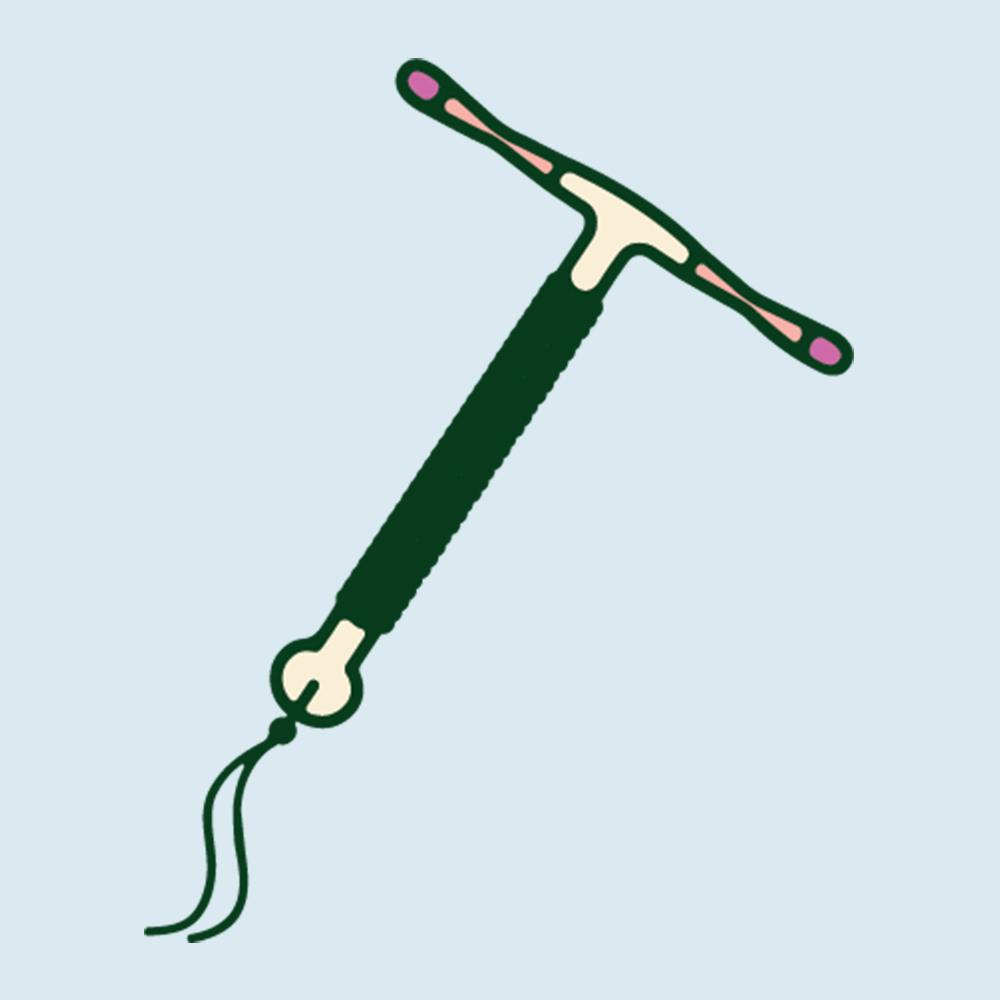Despite being one of the safest and most effective contraception methods, the copper coil (AKA “the IUD”), often gets a bad rap.
Like any method of contraception, the intrauterine device (IUD) comes with a certain amount of risk. Many people, however, still believe the horror stories about the coil – most of which are unfounded.
In the name of myth-busting, we’re here to dispel some of the most common misconceptions about the copper IUD.
Are all IUDs the same?
There are two types of coils: hormonal and non-hormonal. The hormonal coil, or intrauterine systems (IUS), releases a small amount of synthetic progesterone every day.
Non-hormonal IUDs, however, rely on a copper coil filament which continuously acts as a contraceptive.
How does the copper coil work?
The main purpose of an IUD is to prevent fertilisation from occurring. It releases small doses of copper in your uterus that alter your cervical mucus and makes it more difficult for sperm to travel to your uterus.
Copper also makes the uterus inhospitable for sperm by creating a local inflammatory reaction within the endometrium.
On the very unlikely chance that a sperm manages to slip through and successfully fertilise an egg, this inflammation stops the egg from implanting in the uterus.
Are IUDs effective?
The IUD is 99% effective, rivalling sterilisation. This means that fewer than one in 100 women will get pregnant each year with an IUD. For reference, nine out of 100 women who take oral contraceptives will get pregnant.
The IUD is a method of long-acting reversible contraception (LARC), also known as “fit and forget.” They can be kept in for up to 10 years, depending on the brand and type.
Side effects of IUDs
The most common side effect of the copper coil is cramping. This occurs immediately after insertion but should settle after three to six months. Other common (and temporary) side effects may include:
- back pain
- bleeding between periods
- painful intercourse
- heavier periods
Will a copper coil make my periods worse?
Not necessarily. However, painful, heavier periods are a common side-effect of IUDs.
It’s unclear why IUDs cause bleeding or make period cramps worse, but it’s thought to be related to an inflammatory reaction that is toxic to sperm.
If you already experience painful periods, it might be worth considering an alternative method of contraception.
Is the copper coil safe?
Since the IUD doesn’t have hormones, it doesn’t interfere with other medications and is safe to use while breastfeeding.
While some copper coil users have negative experiences, many state that their experiences are outweighed by positive ones.
Just like any contraceptive method, there isn’t a “one-size-fits-all” choice that’s perfect for everyone.
Copper toxicity & IUDs
This is one of the most common myths associated with the IUD.
Although there is a small amount of anecdotal evidence of women reporting symptoms of copper toxicity, there is no research to prove the risk of copper poisoning – this is because the levels of copper from the IUD are not high enough to cause toxicity.
Ultimately more research needs to be done on this link.
Do IUDs increase the chances of vaginal infection?
There is a very small risk of infection (less than 1%) in the first 20 days after insertion. If you have an untreated infection at the time your IUD is fitted, this could lead to a pelvic infection like pelvic inflammatory disease (PID), but the risk of this happening is also low.
PID is caused by an infection (such as a STI like chlamydia) travelling up your genital tract. Your doctor should check for infections before fitting the IUD.
If an STI or vaginal infection is detected, your doctor won’t be able to insert the IUD.
Do IUDs increase the risk of thrush and BV?
Many women also fear that their IUD increases their risk of thrush and BV, but the link between the two is tenuous at best.
The theory is that yeasts and bacteria can adhere to IUD strings and make infection more likely, but a recent review didn’t find convincing evidence due the studies being flawed, so more research needs to be done.
However, the Faculty of Sexual and Reproductive Healthcare (FSRH) does recommend that if a woman has recurrent BV – and no other risk factors have been found – alternative contraception options should be discussed.
If you already suffer from recurrent thrush or BV and are concerned, it’s worth speaking to your GP before getting an IUD fitted.
Risk of IUDs & ectopic pregnancies
Researchers used to think this was the case, but this has since been disproven. An ectopic pregnancy (also known as a tubal pregnancy) occurs when a fertilised egg implants outside of the uterus, usually in the ovary, fallopian tube, abdomen, or cervix. This carries significant medical risk, including life-threatening bleeding.
Ectopic pregnancies are less likely to occur while using an IUD than any other method of contraception, or no contraception at all. This is because the IUD is so effective in preventing pregnancy and has an extremely low failure rate.
Can the IUD puncture my uterus?
The chances of uterine perforation with an IUD are very small (around one in 1000), and tend to be caused by an inexperienced doctor or nurse fitting the IUD.
The symptoms of uterine perforation are usually mild abdominal pain and bleeding. In fact around 30% of women don’t experience any symptoms at all. If you do have symptoms and can’t feel the strings of the IUD when self-checking, go and see your doctor.
While there are medical reports of IUDs migrating into the abdominal cavity, it is incredibly rare. This is why regularly checking for your copper coil’s strings is incredibly important. IUD bowel perforation symptoms include:
- bowel changes
- severe abdominal pain
- fever
- bleeding
How to tell if your body expels an IUD
The risk of expelling an IUD is one in 20, and is most likely to happen in the first three months after it has been fitted (or if you have previously expelled one).
Many women don’t realise they have expelled their IUD, which is why doctors will advise you to periodically check that it’s still in place after being fitted.
You can perform a self-examination by inserting your fingers inside your vagina and feeling the strings of the IUD poking from your cervix.
If you can’t feel your threads, don’t panic. The average vagina is longer than a finger, and from experience, I can tell you that self-checking if the strings are in place is easier said than done!
How is a copper coil inserted?
A specialised nurse or GP will ask you to lay on an exam table with your legs up. They will gently insert a speculum to widen your vaginal opening. Next, they will use antiseptic on your cervix and vagina while checking for any irregularities.
The healthcare professional will fold down the IUD’s arms, place it within an applicator tube, and insert said tube through the opening of your cervix into your uterus.
Once in place, the IUD’s arms will release and the applicator tube will be removed. Finally, the strings between your cervix and vagina will be trimmed.
In the UK, doctors and nurses need special training to fit an IUD, so the service won’t be available in all sexual health clinics or GP surgeries. Make sure to check that your local clinic can fit an IUD for you.
Does IUD insertion hurt as much as they say?
Pain is very subjective, so when an IUD is inserted, it will be different for everyone. It’s a relatively quick procedure that is done without the need for anaesthetics, but for many people IUD insertion causes cramping similar to period cramps.
In some cases it can be very painful. It’s hard to know how painful it will be ahead of time, but if you’re concerned, talk to your GP or healthcare provider.
Will my partner feel the IUD during sex?
Unlikely, but it can happen. The IUD itself is placed inside the uterus, so it’s completely out of the way during penetrative sex.
Your partner may feel the IUD strings, though, as they poke outside of the cervix and into the vaginal canal.
In this case, you can ask your GP to shorten the strings. If either you or your partner feel discomfort or pain during sex, speak to your doctor.
Will the IUD affect my fertility?
The copper coil has no bearing on fertility as it does not contain hormones. Fertility goes back to normal as soon as the IUD is removed, so you can get pregnant right away.
Is an IUD good emergency contraception?
The copper IUD can be used as a form of emergency contraception, and can be fitted up to 5 days after having unprotected sex. However, it is primarily designed to be used as normal contraception.
Can I still use tampons and menstrual cups with an IUD?
While it is safe to use tampons and menstrual cups with an IUD fitted, a recent study found that the risk of IUD expulsion was four times higher in women who used menstrual cups versus tampons.
Within two years, 23% of the women reported their IUD coming out when using menstrual cups (compared to just 6% for those who didn't). If you use a menstrual cup, be careful not to pull on the IUD strings when removing it.
The study is quite small when you compare it to the number of women who safely use menstrual cups, but it's something to keep in mind if you’re thinking of getting an IUD.






